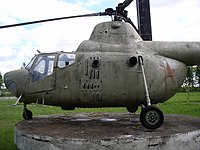Mil Mi-28 "Havoc"
The Mil Mi-28 (NATO reporting name 'Havoc') is a Russian all-weather, day-night, military tandem, two-seat anti-armor attack helicopter. It is a dedicated attack helicopter with no intended secondary transport capability, better optimized than the Mil Mi-24 for the role. It carries a single 30mm gun in an undernose barbette, plus external loads carried on pylons beneath stub wings.
In 1972, following completion of the Mil Mi-24, development began on a unique attack helicopter with transport capability. The new design had a reduced transport capability (3 troops instead of 8) and omitted the cabin, to provide better overall performance and higher top speed. Improved performance was important for its intended role fighting against tanks and enemy helicopters and covering helicopter landing operations. Initially, many different designs were considered, including an unconventional project with two main rotors, placed with engines on tips of wings (in perpendicular layout), and with an additional pusher propeller on the tail. In 1977, a preliminary design was chosen, in a classic single-rotor layout. It lost its similarity to the Mi-24, and even the canopies were smaller, with flat surfaces. Design work on the Mi-28 began under Marat Tishchenko in 1980.[3] In 1981, a design and a mock-up were accepted. The prototype (no. 012) was first flown on 10 November 1982. The second prototype (no. 022) was completed in 1983. In 1984, the Mi-28 completed the first stage of state trials, but in October 1984 the Soviet Air Force chose the more advanced Kamov Ka-50 as the new anti-tank helicopter. The Mi-28 development was continued, but given lower priority. In December 1987 Mi-28 production in Rosvertol in Rostov on Don was approved.
In January 1988 the first Mi-28A prototype (no. 032) flew. It was fitted with more powerful engines and an "X" type tail rotor instead of the three-blade version. The Mi-28A debuted at the Paris Air Show in June 1989. In 1991 the second Mi-28A (no. 042) was completed. The Mi-28A program was cancelled in 1993 because it was deemed uncompetitive with the Ka-50, and in particular, it was not all-weather capable.
The Mi-28N was unveiled in 1995, the N designation meaning "night". The prototype (no. 014) first flew on 14 November 1996. The most significant feature is a radar in a round cover above the main rotor, similar to that of the American AH-64D Apache Longbow. Mi-28N also has improved Tor vision and an aiming device under the nose, including a TV camera and FLIR. Due to funding problems, development was interrupted. A second prototype with an improved rotor design was unveiled in March 2004 at Rosvertol. Changes in the military situation after the Cold War made specialized anti-tank helicopters less useful. The advantages of the Mi-28N, like all-weather action ability, lower cost, and similarity to the Mi-24, have become important. In 2003, the head of Russian Air Forces stated that the Mi-28N and Ka-50 attack helicopters will become the standard Russian attack helicopter. The first serial Mi-28N was delivered to the Army in 2006.[5][6] By 2015, 67 Mi-28Ns are planned to be purchased, when the Mi-24 is to be completely replaced.[6][7] Mil also developed an export variant of the Mi-28N, designated Mi-28NE, and a simpler day helicopter variant, the Mi-28D, based on the Mi-28N design, but without radar and FLIR.
General characteristics
- Crew: 1 pilot (rear), 1 navigator/weapons operator (front)
- Length: 17.01 m (55 ft 10 in)
- Rotor diameter: 17.20 m (56 ft 5 in)
- Height: 4.70 m (15 ft 5 in)
- Disc area: 232.35 m² (2,501 ft²)
- Empty weight: 8,600 kg (18,960 lb)
- Loaded weight: 10,700 kg (23,590 lb)
- Max. takeoff weight: 11,500 kg (25,350 lb)
- Powerplant: 2 × Klimov TV3-117VMA turboshaft, 1,636 kW (2,194 shp) each
Performance
- Maximum speed: 320 km/h (172 knots, 199 mph)
- Cruise speed: 270 km/h (145 knots, 168 mph)
- Range: 435 km (234 nmi, 270 mi)
- Combat radius: 200 km (108 nmi, 124 mi); with 10 min loiter and 5% reserves
- Ferry range: 1,100 km(593 nmi, 683 mi)
- Service ceiling: 5,700 m (19,000 ft)
- Rate of climb: 13.6 m/s (2,677 ft/min)
Armament
- Guns: 1× chin-mounted 30 mm Shipunov 2A42 cannon with 250 rounds (±110° horizontal fire)
- Hardpoints: Two pylons under each stub wing to mount bombs, rockets, missiles, and gun pods. Main armament configurations include:
- 16 Ataka-V anti-tank missiles and 40 S-8 rockets, Or
- 16 Ataka-V anti-tank missiles, and 10 S-13 rocket, Or
- 16 Ataka-V anti-tank missiles, and two 23 mm Gsh-23L gun pods with 250 rounds each.
- Other ordnance: 9K118 Sheksna and 9A-2200 anti-tank missiles, 8 Igla-V and Vympel R-73 air-to-air missiles, 2 KMGU-2 mine dispensers










.jpg)




















